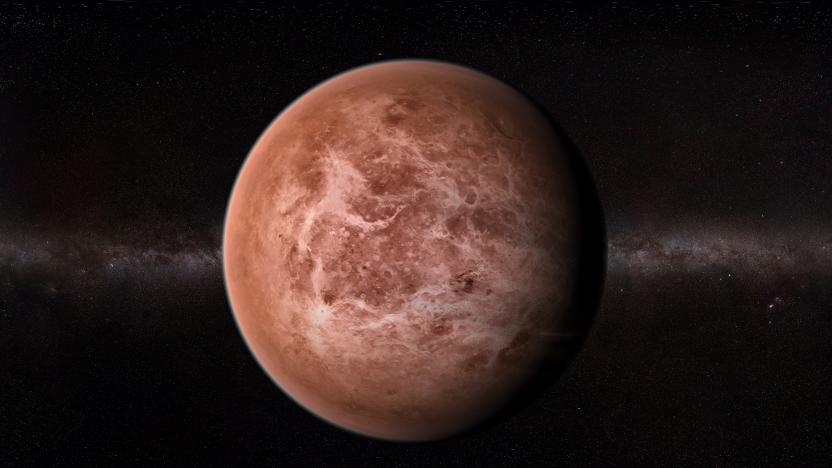microorganisms
Latest

Astronomers detect possible signs of life in Venus's atmosphere
Some astronomers believe phosphine detected on Venus was produced by living microorganisms.

Creating electricity from a bog in a bomb crater
They might not deliver as much electricity as solar panels and windmills, but Geobacter have an extra talent. The microorganisms can purify water by consuming waste, then excrete electrons we can harvest as energy. To show that in action, Artist Teresa van Dongen has created an installation called Mud Well that illuminates, as it were, their inner workings.

Scientists take detailed pictures of the smallest known life forms
Just how small can life get? Almost unbelievably small, if you ask a team of Berkeley Lab researchers. They've taken the first detailed electron microscope pictures of the tiniest bacteria known to date -- at a typical 0.009 cubic microns in volume, you could fit 150 of them in an already miniscule e. coli cell. Scientists had to catch the hard-to-spot microbes by using a new portable cryo plunger, which flash-froze groundwater to near absolute zero (about -458F) to keep the cells intact while they were in transit.

Researchers pit microorganisms in deadly game of 'PAC-mecium'
At first glance, the so-called "biotic games" research conducted by a Stanford University team that's installed microorganisms into crude, real-life video games merely raises the question: Wow -- that's a job? A summary of the team's experimentation on living organisms (red flag!) in this month's Lab on a Chip journal suggests that biotic games could "have significant conceptual and cost-reducing effects on biotechnology and eventually health care," not to mention that they could also "educate society at large to support personal medical decisions and the public discourse on bio-related issues." Those sure sound like complicatedly-worded, yet noble goals -- or at least good cover for playing video games all day -- but we sense a distressing undertone in the work here. Just watch the clip (after the break) of the researchers' Pac-Man prototype clone, "PAC-mecium," wherein, ostensibly, a player would "guide" unwitting paramecia to happy-face yeast pellets and attempt to keep the poor protozoa from being devoured by a giant zebrafish larvae, or not. It's pretty clear to us that the next "guinea pigs" in this diabolical plan will be mice, and then probably monkeys. The final stage? Gerard Butler.

Scientists developing E.Coli bacteria that stores, encrypts data
Apparently it's not good enough for bacteria to cause leprosy and tuberculosis any more, as scientists have been hard at work adapting the microorganisms for use as everything from microbial fuel cells to really, really small gears. Now, researchers at the Chinese University of Hong Kong have developed a way to use a colony of E.Coli for data storage and encryption. The technique involved placing data (in this case, The Declaration of Independence) in the DNA of bacterial cells, and can even harness site specific genetic recombination to encrypt the data. That said, the technology is still in its infancy: retrieving the info is "tedious and expensive," according to Cambridge University's Tim Middleton, and there is still the possibility that as organisms mutate, so will the data. Currently the only application of all this is the storage of copyright info in genetically engineered organisms, although further research might yield a bacterial storage medium that could survive the electromagnetic pulses and radiation of nuclear fallout.

NASA paper on arsenic-bred organisms finds phosphorous-based detractors
Calm down, everyone, please take your seats. Now, no one here is saying arsenic-bred life is impossible -- they're not saying that, so your science fiction novel (which should be beyond the outline phase and in rough draft form) is conceptually fine. But, as you might have heard, there are a number of scientists -- including some that co-authored a 2007 paper that called for such arsenic-based research -- who are calling into question the paper behind NASA's big astrobiological announcement, noting what they see as "fatal flaws" and errors in methodology. Frankly, this kind of thing happens with most-to-all science papers, but given all the self-made hooplah surrounding the unveil, a public opposition seems poetically appropriate. Expect this toxic fight to propagate throughout an assortment of scientific journals, the initial test trialed numerous times over in hopes of recreating (and further verifying). Make no mistake, someone'll be bringing a beaker to the test tube fight.

NASA reveals arsenic-bred organisms, search for life gets broader parameters
If you were hoping NASA was going to announce the very first tweet from an extraterrestrial being, sorry to break your heart -- it is astrobiological, but the findings are actually borne of this rock. Researchers in Mono Lake, California, have discovered a microorganism (pictured) that uses arsenic instead of phosphorous to thrive and reproduce. The latter, as far as terrestrial life is concerned, is a building block of life along with carbon, hydrogen, nitrogen, oxygen, and sulfur, all integral to our DNA and RNA. Arsenic, meanwhile, is generally considered poisonous -- but "chemically it behaves similarly to phosphate," apparently making for a good substitution. In other words, NASA's proven that life can be made with components different than our current assumptions, both locally and beyond the stars. Seems entirely logical, if you ask us. (A silicon-based Horta, Mr. Spock?) So, what about other atypical life-forming chemicals? NASA isn't speculating. That sound you hear is a thousand light bulbs popping up as science fiction writers everywhere conjure up brand new super villains -- and a thousand Chemistry professors writing new extra credit questions for their fall semester finals.


